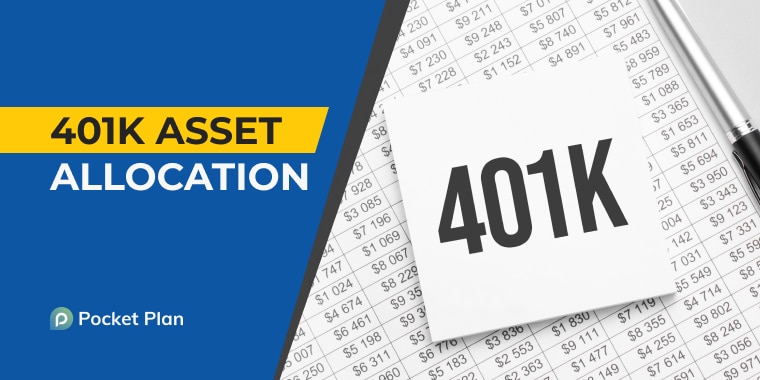Your 401(k) asset allocation is an essential factor to successful retirement planning. Your 401k asset allocation is the mix of investments within your 401k. The mix of investments or asset allocation helps to ensure that your investment portfolio is aligned with your long-term goals and risk tolerance. If you haven’t reviewed your asset allocation in a while, or you’re unsure of where to start, don’t worry. This article will guide you through the process of rebalancing your 401(k) asset allocation.
Understanding Asset Allocation
Asset allocation refers to the way in which you divide your investment portfolio among different asset classes, such as stocks, bonds, and cash. Each asset class carries its level of risk and potential returns. For example, stocks are typically more volatile than bonds, but they also offer the potential for higher returns over the long-term.
The goal of asset allocation is to create a diversified portfolio that balances risk and potential return. By diversifying your investments, you can reduce the impact of any one investment’s poor performance on your overall portfolio.
The Importance of Rebalancing
Asset allocation is not a one-time decision; it requires regular monitoring and adjustments. As market values fluctuate over time, your portfolio’s allocation will shift, potentially exposing you to higher levels of risk than you initially intended. Rebalancing is the process of adjusting your asset allocation to bring it back to its original allocation targets.
Rebalancing is crucial because it helps ensure that your portfolio remains aligned with your risk tolerance and financial goals. It also forces you to sell high and buy low, which is the opposite of what many investors do.
Rebalancing Frequency
The frequency at which you rebalance your portfolio will depend on your investment goals and risk tolerance. Some investors may rebalance annually, while others may choose to do so every few years. It’s essential to have a plan and stick to it, regardless of market conditions.
If you’re unsure of how often to rebalance, consider using a rule of thumb. For example, the 5/25 rule suggests rebalancing your portfolio if any asset class deviates more than 5% from its target allocation or if your overall portfolio’s allocation deviates more than 25% from your target allocation.
How to Rebalance Your 401(k) Asset Allocation
1. Review Your Current Asset Allocation
The first step in rebalancing your 401(k) asset allocation is to review your current allocation. Most 401(k) providers offer tools that allow you to view your allocation by asset class. Reviewing this information can help you identify any areas of your portfolio that may need adjustment.
2. Determine Your Target Allocation
Once you’ve reviewed your current allocation, you’ll need to determine your target allocation. Your target allocation should be based on your investment goals, risk tolerance, and time horizon. For example, if you have a long-term investment horizon and are comfortable with risk, you may choose to have a higher allocation to stocks than bonds.
3. Identify the Asset Classes That Need Adjustment
Compare your current allocation to your target allocation and identify any asset classes that need adjustment. For example, if your target allocation is 60% stocks and 40% bonds, but your current allocation is 70% stocks and 30% bonds, you may need to sell some stocks and buy bonds to bring your allocation back in line with your target.
4. Determine Your Rebalancing Strategy
Once you’ve identified the asset classes that need adjustment, you’ll need to determine your rebalancing strategy. You can either sell some of the over-allocated asset class and buy the under-allocated asset class or direct new contributions to the under-allocated asset class until your allocation is back in line with your target.
5. Implement Your Rebalancing Strategy
After you’ve determined your rebalancing strategy, it’s time to implement it. If you’re rebalancing by selling and buying, you’ll need to place trades to execute the transactions. If you’re directing new contributions, you’ll need to adjust your contribution allocations. Be sure to double-check your work and confirm that your allocation is now in line with your target.
6. Monitor Your Portfolio Regularly
After rebalancing your portfolio, it’s important to continue monitoring it regularly. Market conditions can quickly shift your allocation, and you may need to rebalance again sooner than you expect. Set up a reminder to review your allocation periodically, and be prepared to make adjustments as needed.
Conclusion
Rebalancing your 401(k) asset allocation is an important part of retirement planning. It helps ensure that your investment portfolio remains aligned with your goals and risk tolerance. The process of rebalancing may seem daunting at first, but it’s relatively straightforward once you understand the steps involved. Review your current allocation, determine your target allocation, identify the asset classes that need adjustment, determine your rebalancing strategy, implement your strategy, and monitor your portfolio regularly. By following these steps, you can maintain a diversified and balanced portfolio that will help you achieve your long-term financial goals.









